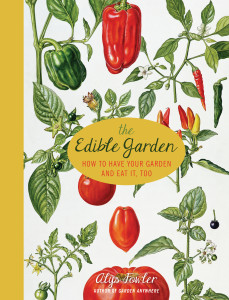 No gardener has room for it all, but author Alys Fowler intentionally breaks the rules to show how you can “have your garden and eat it, too,” in her new book, “The Edible Garden.”
No gardener has room for it all, but author Alys Fowler intentionally breaks the rules to show how you can “have your garden and eat it, too,” in her new book, “The Edible Garden.”
Read on for how you can win a free copy of this 250-page book.
Trained at the Horticultural Society, the New York Botanical Garden and the Royal Botanic Garden at Kew, Fowler also is a BBC personality in the U.K.
Full of gorgeous photos in muted colors, the book covers the full spectrum from starting a garden, to what to grow, harvesting, home cooking and brews.
The book demonstrates:
· Gardening 101: How to get your garden started
· What to sow and where (in a pot, on a windowsill, in the ground)
· How to grow vegetables that taste good, provide a plentiful harvest, and look beautiful
· Create gorgeous and edible gift bouquets
· Save and store seeds
· Turn your harvest into delicious jams, jellies, chutneys, soups, cakes, teas, and liquors
Some of the book might not pertain to a Midwest garden, but it’s fun to read about plants such as Salsola, a salt marsh plant – also known as land seaweed – that can grow in water and soil with high levels of salt. Overall, the book is full of practical tips that can carry over to any garden, anywhere.
And where some gardening books end outdoors, Fowler brings it inside with her favorite recipes for jams, soups and more, including one of the latest trends in fermentation.
In between, she adds tidbits on topics such as how to control slugs using common items like coffee grounds and egg shells, and the best combination for an herb bouquet.
An excerpt from her book follows. The book can be purchased online here and the publishers are offering one copy free to the winner of our latest Homegrown Facebook contest.
Help Homegrown reach its next level of “Likes” by sharing a post on your own page. Anyone who shares the Homegrown contest post will be entered in a drawing to win a copy of “The Edible Garden; How to Have Your Garden and Eat It, Too.”
The contest will run three weeks: from Friday, Nov. 29, 2013, through Friday, Dec. 20, 2013. I’ll draw one entrant as the winner and post the name on Dec. 21.
Now, some advice from Alys Fowler’s book on home composting…
Guide to Making Your Own Compost:
Making good compost is a bit like making a cake. The ingredients need to be in the right proportions. You need roughly two-thirds carbon to one-third nitrogen, which translates as a lot more brown stuff than green. The brown stuff (carbon) comes from fibrous material, such as twigs, woody stems, straw and cardboard, so stop sending your recycling to the kerb and add it to the compost instead. Green stuff is fresh leaves, grass clippings, flowers, weeds and soft stems.
Try to build your compost up in layers, no more than 15 cm (6in) deep. The more air (and moisture) you give your compost the more efficiently the bacteria will work as oxygen is vital to the aerobic bacteria that break down compost. The faster they work, the hotter your compost gets and more weeds, seeds, pathogens and plant diseases get thoroughly broken down.
If you are using a plastic Dalek (the council black compost bin) I recommend drilling holes around the base to let more air in, otherwise the bin can quickly produce anaerobic conditions and slimy compost. Wooden, square bins made from recycled palettes are good, as you can make more than one if you have space so you can turn one bin into the next. The simplest square bin is just a cage of wire mesh around four stakes, and you can even make a bin our of an old chest freezer (called a hot box). There are endless designs and how-to’s on the Internet.

No Comments Yet